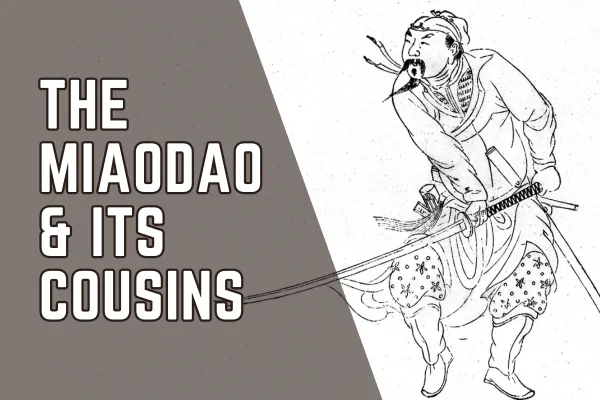
The Miaodao & Its Cousins
The Miaodao & Its Cousins
“While the Miaodao, Changdao, Dandao, Pudao, and Dadao share a family resemblance, each was a unique development with its own origins.”
Introduction
Chinese two-handed swordsmanship has a history stretching back more than two thousand years, to the reign of the first unifying emperor, Qin Shi Huang (260–210 BCE). Among the many systems that developed, the Miaodao stands out for its role in both military training and martial tradition.
But the Miaodao does not exist in isolation. To truly understand it, we need to place it alongside its cousins — the Changdao, Dandao, Pudao, and Dadao — each of which reflects the changing needs of Chinese soldiers and society.
1. The Four Roads Miaodao (Si Lu Miaodao)
The form most widely practiced today, the Si Lu Miaodao (四路苗刀, “Four Roads Miaodao”), has four distinct sections. These variations, found across northern China in the Qing and Republican eras, were simple, practical, and focused on two-handed use.
Han Jingtan developed the modern version while studying under Guo Changshen at the Central Guoshu Academy in Nanjing. Condensed from longer earlier forms, it was adopted by the Chinese military during the early Republic to train soldiers, and later used in World War II. Unlike later wushu forms, it retained its direct martial character.
Training with the Miaodao today typically follows the same progression:
Basic cuts
Solo form practice
Partner drills
Applications for free swordplay
2. The Origins of Chinese Long Sabers
The use of long two-handed weapons waxed and waned throughout Chinese history. A major resurgence occurred in the late Ming dynasty, when Chinese infantry faced threats from Mongol and later Manchu cavalry. Military leaders turned to longer sabers to give soldiers the reach and power needed against mounted opponents.
Two-handed weapons provided:
Reach: A foot soldier with a 28-inch saber couldn’t strike effectively at mounted riders, but a longer blade could.
Power and stability: Wielded with both hands, long sabers delivered stronger cuts and deflections.
Familiarity: Many recruits were former farmers or fishermen, already accustomed to long-handled tools like hoes and axes.
The result was a natural fit for large numbers of inexperienced soldiers.
3. Changdao – The “Long Saber”
General Qi Jiguang (1528–1588) is often mistakenly credited as the father of the Miaodao. In fact, he armed some of his troops with long sabers called Changdao (長刀).
His recorded Changdao form was extremely simple, employing four basic cuts. Two techniques — the thrust and the “wipe” (shi) with a reverse grip — appear only once. This shows that Qi did not give the weapon special emphasis. While the Changdao physically resembles the later Miaodao, the connection between the two is superficial.
4. Dandao – Saber vs Spear
Another important system was the Dandao (單刀), preserved in the illustrated manual Dandao Fa Xuan (單刀法選), published in 1616.
This manual is significant as one of the first Chinese martial texts to use step-by-step illustrations. It records 34 techniques, nearly all taught in relation to spear attacks. This focus reflects the author Cheng Zongyou’s southern coastal environment, where pirate raiders frequently wielded spears.
Even though written as anti-spear methods, many of the techniques can be adapted against other weapons.
5. Pudao – The Civilian Long Saber
The Pudao is a two-handed saber with a clipped tip, described in late Ming manuals. At that time it was considered a civilian weapon, so its length, weight, and curvature were not standardized as military blades were.
Later, during the Qing dynasty’s periods of upheaval, two-handed sabers reappeared in the hands of rebels and militias. Many of these were shorter varieties, closer to the Dadao.
6. Dadao – The “Big Knife”
The Dadao (大刀) became the most famous Chinese two-handed saber of the 20th century. Employed by both militias and regular troops, the Dadao was shorter than the Miaodao but delivered devastating cutting power.
It was famously used by the Dadao Dui (“Big Knife Unit”) during battles along the Great Wall, where poorly armed Chinese soldiers attacked Japanese troops with nothing more than their sabers. Their bravery — and the effectiveness of the weapon — left a lasting legacy.
7. Shared Roots, Unique Identities
It is easy to lump all Chinese two-handed sabers together under the name “Miaodao.” But while these weapons share similarities, each has its own origin, tactical purpose, and emphasis:
Miaodao – Qing/Republican era military training, four-road form.
Changdao – Qi Jiguang’s long saber, late Ming, very simple form.
Dandao – Anti-spear system from 1616 manual, 34 techniques.
Pudao – Civilian long saber with clipped tip.
Dadao – 20th-century “Big Knife,” used in WWII.
Together, they paint a complex picture of how Chinese martial culture adapted weapons to the needs of each era.
📺 Watch More
⚔️ Continue Your Study
At the Academy of Chinese Swordsmanship, we offer structured online programs in Jian, Dao, Miaodao, and other Chinese sword traditions. Learn step by step, from foundation drills to free swordplay, supported by a global community of practitioners.
